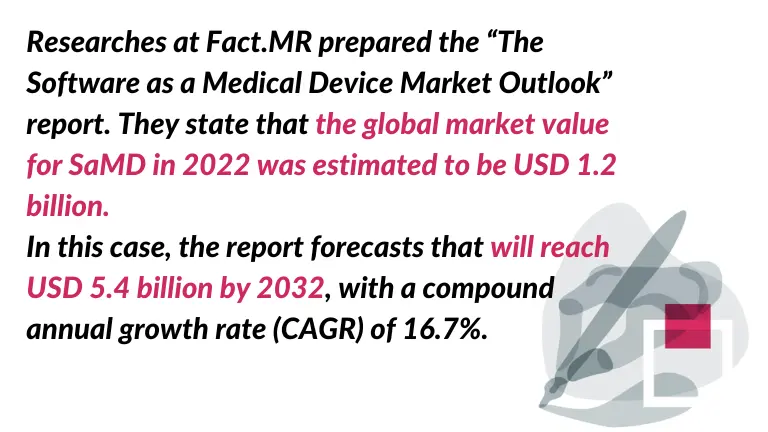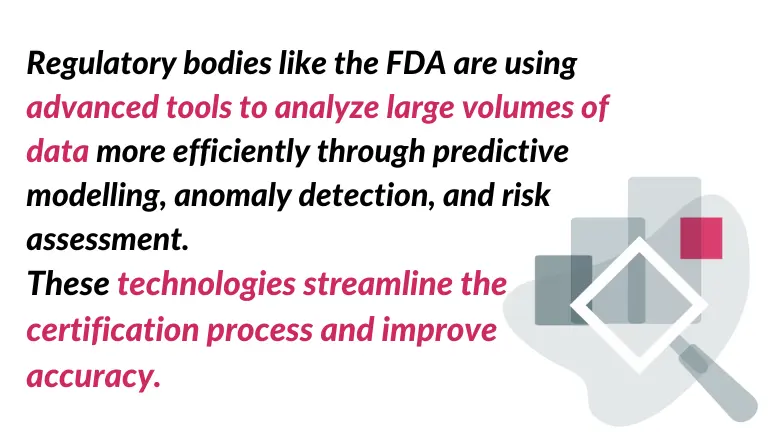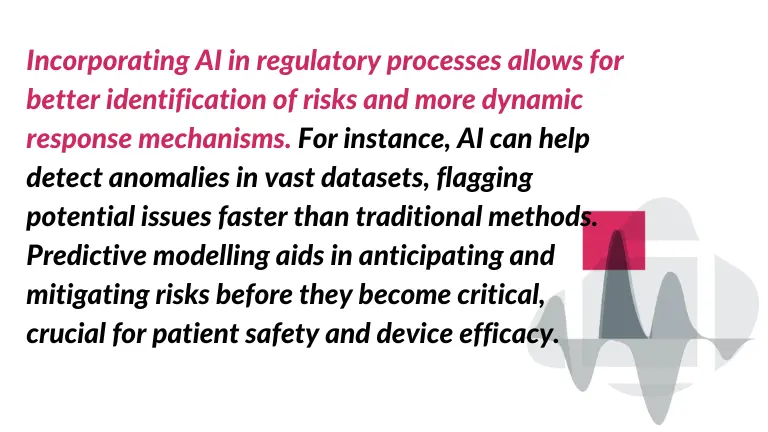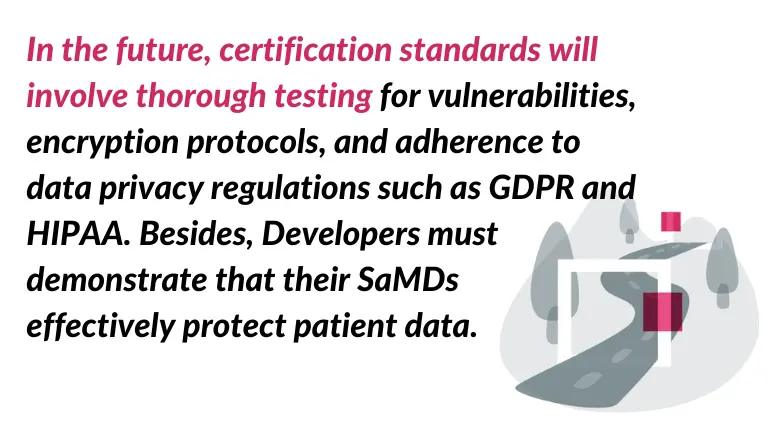The future of SaMD certification: trends and technologies
Powerful patient databases requiring security, the drive to automate medical systems, using artificial intelligence to support doctors in decision-making, and also patient safety. These are just some issues that companies address as they create and develop Software as a Medical Device (SaMD). This solution must undergo a complex and restrictive SaMD certification process.
SaMD certification: a glimpse into the future
Software as a Medical Device has rapidly transformed the healthcare landscape. Particularly, provides innovative solutions for diagnosing, treating, and managing various medical conditions.

Researches at Fact.MR prepared the “The Software as a Medical Device Market Outlook” report. They state that the global market value for SaMD in 2022 was estimated to be USD 1.2 billion. In this case, the report forecasts that will reach USD 5.4 billion by 2032, with a compound annual growth rate (CAGR) of 16.7%. [1]
As the reliance on SaMD grows, there is an increasing need for robust certification processes. So, the certification is crucial to ensure safety, efficacy, and compliance with regulatory standards. In short, the future of SaMD certification is set to evolve with emerging trends and technologies that promise to streamline and enhance this critical solution.
Regulatory harmonization in the medicine software field
The SaMD certification is currently trending towards regulatory harmonization, aiming to create a more unified regulatory environment. Meanwhile, varying regulatory frameworks across different countries can be a major hurdle for companies looking to market their products globally. E.g. initiatives like the International Medical Device Regulators Forum (IMDRF) are working to simplify the certification process. Especially, they plan to reduce time-to-market and ensure consistent safety standards across borders.
AI and Machine Learning in SaMD certification process
At the present time, Artificial Intelligence (AI) and Machine Learning (ML) are becoming integral to SaMD development. In detail, these technologies are being used in applications like disease diagnosis, treatment recommendation, and personalized medicine.
However, the integration of AI into Software as a Medical Device presents new challenges for certification.
Regulatory authorities will need to establish guidelines for assessing the safety and effectiveness of AI-powered algorithms, ensuring transparency and clarity in their decision-making processes.
-
AI in the regulatory process
Regulatory bodies like the FDA are using advanced tools to analyze large volumes of data more efficiently through predictive modelling, anomaly detection, and risk assessment. These technologies streamline the SaMD certification process and improve accuracy. The FDA’s AI/ML Action Plan, released in January 2021, outlines steps to enhance oversight of AI/ML-based SaMD. This plan includes developing a regulatory framework that allows for continuous updates and learning in AI systems, essential for maintaining safety and efficacy in rapidly evolving technologies. The framework also emphasizes real-world performance monitoring, where continuous learning systems update and refine certification criteria based on new data and real-world performance of SaMDs (FDA) (Mondaq). [2], [3]
Moreover, the FDA supports the development of Good Machine Learning Practices (GMLPs), covering best practices in data management, algorithm training, interpretability, evaluation, and documentation. This effort aims to harmonize standards across the industry and ensure robust, bias-free AI systems (MedTech Intelligence) [4].

-
Enhanced risk detection and adaptable reaction systems
Incorporating AI in regulatory processes allows for better identification of risks and more dynamic response mechanisms. For instance, AI can help detect anomalies in vast datasets, flagging potential issues faster than traditional methods. Predictive modelling aids in anticipating and mitigating risks before they become critical, crucial for patient safety and device efficacy (FDA). [5]
Overall, the integration of AI and machine learning into the SaMD certification framework represents a significant advancement. It improves the efficiency and accuracy of the certification process. And ensures that safety and performance standards keep pace with technological innovations. The continuous learning approach allows the criteria for certification to evolve. Moreover, reflects real-world data and performance, enhancing the overall reliability and safety of medical devices (FDA) (MedTech Intelligence). [6], [7]

Continuous monitoring and post-market surveillance
Traditional SaMD certification processes often focus on pre-market approval, but the dynamic nature of software requires a shift towards continuous monitoring and post-market surveillance. In general, emerging technologies can play a crucial role here.
The European Commission (EC) and also the U.S. Food and Drug Administration (FDA) have long required post-marketing surveillance (PMS) as a regulated practice. At the present time, guidelines call for gathering, analyzing, and reevaluating data to guarantee the continued safety of medical devices even after they are placed on the market. The use of PMS to guarantee the safety of medical products has received more attention recently. Important to realize, in May 2021, the Medical Devices Directive (MDD) was superseded in Europe by the Medical Device Regulation (MDR), which imposed stricter guidelines on PMS to ensure patient safety. [3], [4] [8], [9]
In the field of developing medical devices, Post-Market Surveillance (PMS) is essential to guarantee the efficacy and safety of these devices. [10]
Cybersecurity and data privacy
As SaMD develops, cybersecurity and data privacy concerns become paramount. Certification processes must evolve to incorporate stringent cybersecurity measures.
In the future, SaMD certification standards will involve thorough testing for vulnerabilities, encryption protocols, and adherence to data privacy regulations such as GDPR and HIPAA. Besides, Developers must demonstrate that their SaMDs effectively protect patient data.

According to the article by Joe Lomako titled “The Essentials for Cybersecurity of Medical Devices”, few innovations in recent memory have done more to transform healthcare than the use of connected technologies. However, they also introduce several potentially significant cybersecurity risks. Like other data sets, health-related data includes confidential information that could be misused when accessed by those with malicious intent. Names and addresses of patients, medical conditions and diseases, prescribed drugs, and therapies, as well as details about insurance coverage, are just some examples of sensitive data collected by connected medical devices that could be vulnerable to cybersecurity threats and breaches. [11]
Conclusions
In summary, regulatory harmonization, integration of artificial intelligence (AI) and machine learning (ML), continuous monitoring, cybersecurity, digital health integration, and patient-centric models are all expected to shape a more efficient and effective certification landscape.
As the field of SaMD continues to evolve, it will be crucial for developers, regulators, and healthcare providers to stay updated on these trends to ensure that patients benefit from the latest advancements in medical technology.
Resources
[1] Software as a Medical Device Market Outlook, Fact.MR, https://www.factmr.com/report/software-as-a-medical-device-market
[2] FDA Releases Artificial Intelligence/Machine Learning Action Plan, FDA: https://www.fda.gov/news-events/press-announcements/fda-releases-artificial-intelligencemachine-learning-action-plan
[3] FDA Releases Action Plan For Artificial Intelligence/Machine Learning-Enabled Software As A Medical Device, Akin Gump Strauss Hauer & Feld LLP: https://www.mondaq.com/unitedstates/healthcare/1029820/fda-releases-action-plan-for-artificial-intelligencemachine-learning-enabled-software-as-a-medical-device
[4] Z. Reed, The Regulatory Aspects of AI/ML-based SaMDMedTech Intelligence: https://medtechintelligence.com/feature_article/the-regulatory-aspects-of-ai-ml-based-samd/
[5] Artificial Intelligence and Machine Learning (AI/ML)-Enabled Medical Devices, FDA: https://www.fda.gov/medical-devices/software-medical-device-samd/artificial-intelligence-and-machine-learning-aiml-enabled-medical-devices
[6] FDA Releases Artificial Intelligence/Machine Learning Action Plan, FDA: https://www.fda.gov/news-events/press-announcements/fda-releases-artificial-intelligencemachine-learning-action-plan
[7] Z. Reed, The Regulatory Aspects of AI/ML-based SaMDMedTech Intelligence: https://medtechintelligence.com/feature_article/the-regulatory-aspects-of-ai-ml-based-samd/
[8] https://www.distillersr.com/resources/meddev-literature-review/the-importance-of-post-marketing-surveillance
[9], [10] https://matrixreq.com/blog/post-market-surveillance-a-guide-for-medical-device-developers
[11] The essentials for cybersecurity of medical devices, Joe Lomako, Med-Tech Innovation, 2023: https://www.med-technews.com/medtech-insights/medtech-regulatory-insights/the-essentials-for-cybersecurity-of-medical-devices/